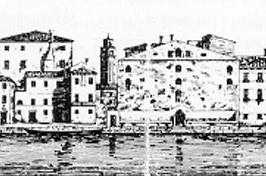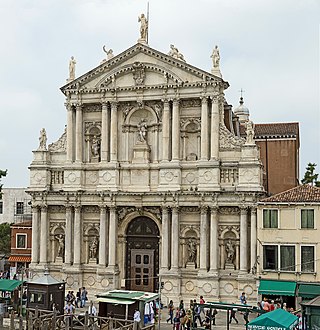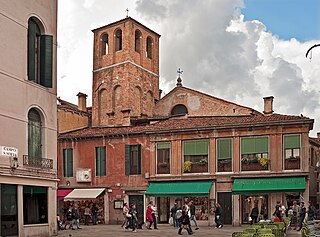
Giovanni Battista Tiepolo, also known as GiambattistaTiepolo, was an Italian painter and printmaker from the Republic of Venice who painted in the Rococo style, considered an important member of the 18th-century Venetian school. He was prolific, and worked not only in Italy, but also in Germany and Spain.

Cannaregio is the northernmost of the six historic sestieri (districts) of Venice. It is the second largest sestiere by land area and the largest by population, with 13,169 people as of 2007.

Ca' Rezzonico is a palazzo and art museum on the Grand Canal in the Dorsoduro sestiere of Venice, Italy. It is a particularly notable example of the 18th century Venetian baroque and rococo architecture and interior decoration, and displays paintings by the leading Venetian painters of the period, including Francesco Guardi and Giambattista Tiepolo. It is a public museum dedicated to 18th-century Venice and one of the 11 venues managed by the Fondazione Musei Civici di Venezia.

Leonardo Loredan was a Venetian nobleman and statesman who reigned as the 75th Doge of Venice from 1501 until his death in 1521. As a wartime ruler, he was one of the most important doges in the history of Venice. In the dramatic events of the early 16th century, Loredan's Machiavellian plots and cunning political manoeuvres against the League of Cambrai, the Ottomans, the Mamluks, the Pope, the Republic of Genoa, the Holy Roman Empire, the French, the Egyptians and the Portuguese saved Venice from downfall.

Andrea Tirali was an Italian architect working in Venice and the Veneto. He was responsible for the intricate design of the pavement in the Piazza San Marco in Venice.

The Palazzo Dario is a palace located between the Palazzo Barbaro Wolkoff and the narrow Rio delle Torreselle on the Grand Canal in the sestiere of Dorsoduro, of the city of Venice, Italy. The palace was built in the Venetian Gothic style and was renovated in Renaissance style.

The Cannaregio Canal is one of the main waterways of Venice, Italy.

The Teatro San Angelo or Teatro Sant'Angelo was once a theatre in Venice which ran from 1677 until 1803.

Santa Maria di Nazareth is a Roman Catholic Carmelite church in Venice, northern Italy. It is also called Church of the Scalzi being the seat in the city of the Discalced Carmelites religious order. Located in the sestiere of Cannaregio, near Venezia Santa Lucia railway station, it was built in the mid-17th century to the designs of Baldassarre Longhena and completed in the last decades of that century.
Venier is a Venetian surname, derived from the Medieval name Venerius. Notable people with the surname include:

Santa Sofia is a church located in the sestiere (neighborhood) of Cannaregio in Venice, Italy. It should be distinguished from the palazzo Ca' d'Oro on the Grand Canal is also called the Palazzo Santa Sofia.
Palazzo di Spagna a San Geremia, also known as Palazzo Frigerio is a palace located on the street Lista di Spagna street #168, once a canal but undergoing landfill in 1844, about midway down the street between the train station and the piazza of the church of San Geremia in the sestiere of Cannaregio, in Venice, Italy. In past centuries, this area of Venice became known for housing foreign embassies, which the secret-obsessed Republic of Venice wished to keep distant from its government buildings.

The Palazzo Priuli Stazio is a Baroque architecture palace located near San Giacomo dell'Orio in the sestiere of Santa Croce in Venice, Italy.

The Palazzo Contarini-Sceriman, also called Palazzo Seriman ai Gesuiti, is a 14th-century palace in the Sestiere of Cannaregio of Venice, Italy. It is located near the church of the Gesuiti.

The Palazzo Benedetti a Santa Sofia is a 14th-century Venetian-Gothic style palace with a characteristic and rare sottoportego or portico at the canal side, located near Santa Sofia in the sestiere of Cannaregio. Across the bridge from the palace is the Palazzo Priuli Stazio. This palace also called the Palazzo di Sottoportico della Guerra.

Palazzo Soranzo Piovene, also called Soranzo Piovene alla Maddalena is a Renaissance-style palace on the Grand Canal, located between the Palazzo Emo at Maddalena and the Palazzo Erizzo, in the sestiere of Cannaregio, in Venice, Italy.

The Palazzo Gussoni Grimani Della Vida, also called Grimani a San Fosca is a Renaissance-style palace on the Grand Canal, located between the Palazetto Barbarigo and the Rio di Noale, in the sestiere of Cannaregio, in Venice, Italy.

Palazzo Savorgnan is a palace in Venice, Italy, located in the Cannaregio district and overlooking Canale di Cannaregio, to the right of Palazzo Priuli Manfrin.
This is an alphabetical index of people, places, things, and concepts related to or originating from the Republic of Venice. Feel free to add more, and create missing pages.
















